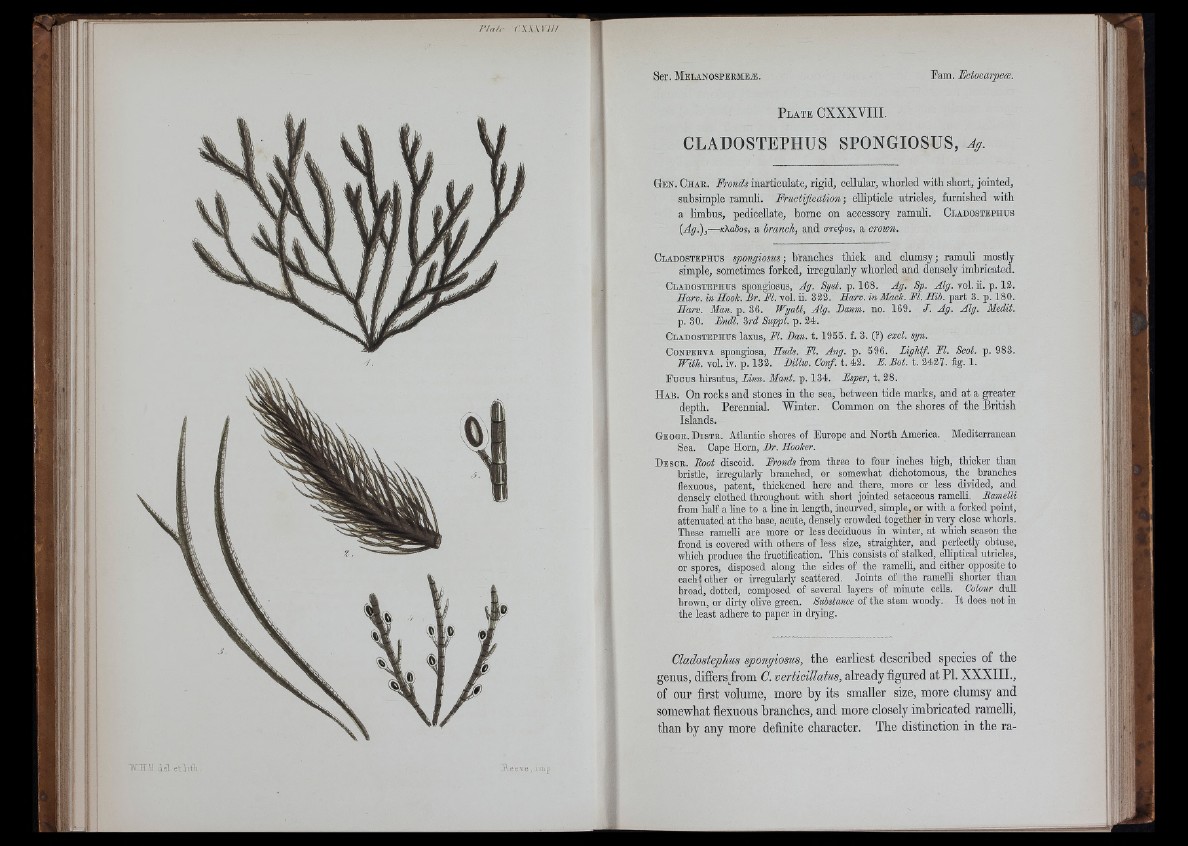
P l a t e CXXXVIII.
CLADOSTEPHUS SPONGIOSUS, Ag.
G e n . Chau. Fronds in a rticu la te , rig id , c ellular, wliorled w ith sh o rt, jo in ted ,
su b sim p le ram u li. Fructification-, e llipticle u tricle s , fu rn ish ed w ith
a lim b u s , pedicellate, b o rn e on accessory ram u li. Gladostephus
{Ag.),—Aados, a branch, a n d arefios, a crown.
Gladostephus spongiosus; branches thick and clumsy; ramuli mostly
simple, sometimes forked, irregularly whorled and densely imbricated.
Gladostephus spongiosus, Ag. Syst. p. 168. Ag. Sp. Alg. vol. ii. p. 13.
Haro, in Hook. Br. M. vol. ii. 322. Harv. in Mack. FI. Hib. pail 3. p. 180.
Harv. Man. p. 36. Wyatt, Alg. Banm. no. 169. J. Ag. Alg. Medit.
p. 80. Endl. 3rd Suppl. p. 24.
Gladostephus laxus, El. Ban. 1 .1955. f. 3. (?) excl. syn.
CoNPEBVA spongiosa, Huds. El. Ang. p. 596. lAglitf. El. Scot. p.
983.
With. vol. iv. p. 132. Billw. Conf. t. 42. E. Bot. t. 3427. fig. 1.
F u cu s hirsntus, Linn. Mant. p. 134. Esper, t. 28.
H ab. On rocks and stones in the sea, between tide marks, and at a g
reater
Iritish
depth. Perenmal. Winter. Gommon on the shores of the 1
Islands.
Geogk. D is t r . Atlantic shores of Europe and North America. Mediterranean
Sea. Gape Horn, B r. Hooker.
D esok. Boot discoid. Eronds from three to four inches high, thicker than
bristle, UTegularly branched, or somewhat dichotomous, the branches
flexuous, patent, thickened here and there, more or less divided, and
densely clothed throughout with short jointed setaceous ramelU. Bamelli
from half a line to a line in length, incurved, simple, or with a forked point,
attenuated at the base, acute, densely crowded together in very close whorls.
These ramelli are more or less deciduous in winter, at which season the
frond is covered with others of less size, straighter, and perfectly obtuse,
which produce the fructification. This consists of stalked, elliptical utricles,
or spores, disposed along the sides of the ramelli, and either opposite to
eacha other or irregularly scattered, Joints of the ramelli shorter than
broad, dotted, composed of several layers of minute cells. Colour dull
brown, or dirty olive green. Substance of the stem woody. I t does not in
the least adhere to paper in drying.
Cladostephus spongiosus, the earliest described species of the
genus, differs from C. verticillatus, already figured at PL XXXIII.,
of our first volume, more by its smaller size, more clumsy and
somewhat flexuous branches, and more closely imbricated ramelli,
than by any more definite character. The distinction in the ra-
:L
1
ft
ill
I
Ii
’H
i
’I ' j j
W.ini arAetiith. IR.ee